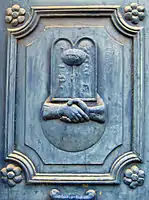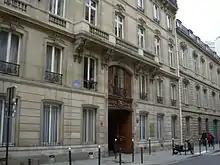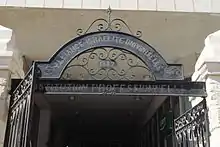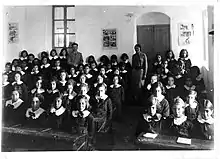Alliance Israélite Universelle
The Alliance israélite universelle (Hebrew: כל ישראל חברים) is a Paris-based international Jewish organization founded in 1860 by the French statesman Adolphe Crémieux to safeguard the human rights of Jews around the world. The organization promotes the ideals of Jewish self-defense and self-sufficiency through education and professional development. It is noted for establishing French-language schools for Jewish children throughout the Mediterranean, Iran and the Ottoman Empire in the 19th and early 20th century.
 | |
| Native name | כל ישראל חברים |
|---|---|
| Founded | 1860 |
| Key people | Mark Ayzenberg, President |
| Website | |

The motto of the organization is the Jewish rabbinic injunction Kol yisrael arevim ze laze (כל ישראל ערבים זה לזה), translated into French as Tous les israélites sont solidaires les uns des autres ("All Jews are responsible for one another").[1]
History

In 1860, Alliance Israelite Universelle embarked on a "mission civilisatrice" to advance the Jews of the Middle East through French education and culture.[2] It was founded in Paris,[3] and opened its first school in Tetouan, Morocco in 1862.[4] The original members of the society were Jews, and by far the largest number of its members belong to that faith, but the association has enjoyed the sympathy and cooperation of many prominent Christians. As outlined in its prospectus, the program of the society included the emancipation of the Jews from oppressive and discriminating laws, political disabilities, and defense of them in those countries where they were subjected to persecution.[3]
For the attainment of its objectives, the society proposed to carry on a campaign of education through the press and by the publication of works on the history and life of the Jews. In the beginning, however, the course of action adopted by the society for bringing relief to their oppressed brethren in other countries was to secure the intercession of friendly governments in their behalf. Thus, as early as 1867 the governments of France, Italy, Belgium, and the Netherlands made the renewal of existing treaties with Switzerland conditional upon that country's granting full civil and political rights to the Jews. In 1878, representatives of the Alliance laid the condition of the Jews in the Balkan Peninsula before the Congress of Berlin, as a result of which the Treaty of Berlin stipulated that in Romania, Serbia, and Bulgaria no discrimination should be made against any religion in the distribution of civil rights.[3]
Schools

Over time, the activity of the Alliance became more focused on education and especially improving the welfare of Jews.[3] Two years after the first school was opened in Tetuan, an Alliance school opened in Baghdad in 1864.[5] In 1870, Charles Netter, a founding member of Alliance israélite universelle, received a tract of land from the Ottoman Empire as a gift and opened the Mikveh Israel agricultural school, the first of a network of Jewish schools in Palestine before the establishment of the State of Israel. Over 60 Alliance schools operated in the Ottoman Middle East, Iran and North Africa, providing Jewish children from poor families with formal elementary school and vocational training. Many of the teachers were educated at Alliance teacher training schools in Turkey and France.[6]
By 1900, Alliance Israelite Universelle was operating 100 schools with a combined student population of 26,000. Its greatest efforts were concentrated in Morocco, Tunisia and Turkey.[4] French was the third most popular foreign language spoken in Palestine by 1914. After decades of teaching in French exclusively, the schools began teaching Hebrew to their students after the eleventh Zionist Congress insisted, amidst the modern revival of the Hebrew language, that it be included in the curriculum.[7]
As a result of the influence of the French-language schools, Judeo-Spanish language acquired lots of neologisms from French.
Schools in Israel

Alliance israélite universelle continues to operate dozens of schools and educational programs in Israel today. Historic schools include the Alliance High School in Tel Aviv, Alliance israélite universelle High School in Haifa, René Cassin High School and the Braunshweig Conservative High School in Jerusalem. The network also includes the School for the Deaf in Jerusalem, in which deaf students, Jews and Arabs, with various mental and physical disabilities study together. The Mikve Israel Youth Village operates a state high school, a state-religious high school specializing in life and natural sciences, environmental sciences, and biotechnology; and a French-Israeli high school established in 2007 as a joint initiative of the Israeli and French governments.[8]
Impact on Girls and Women
The Alliance Israelite Universelle (AIU) changed and shaped the roles and opportunities for women in North Africa. Prior to the establishment of the AIU, primarily girls from wealthy or rabbinical families received an education.[9] Literacy and skilled training provided an opportunity for upward social mobility, especially to Jewish girls of underprivileged backgrounds who could not attain an education previously. Curricula featured foundational mathematics, such as arithmetic, exposure to European subjects such as European geography and the French language.[9] Additionally, girls received vocational training in fields such as needlework, sewing, bookkeeping, secretarial work, laboratory assistance, and industrial chemistry; this training promoted the economic independence of Jewish women in the region.[9] Many North African women were also educated and trained as AIU teachers in France, returning thereafter to their countries of origin in order teach.
Along with economic change, the AIU changed cultural norms for Jewish girls in the Maghreb as well. Primarily, the AIU lobbied to extend the typical marriage age from twelve to fifteen by 1948.[9] This changing role of women led to controversy regarding the secularization of Jewish society through Western-style education.
The AIU and Secularization
The AIU, and more generally, the French colonization of swaths of North Africa, shifted education from the hands of rabbis and religious leaders to secular, European instructors. In Algeria, this shift resulted in a legal mandate: in 1845, a law required Jews of Algeria to be registered in French schools, and to only attend a religious schools as a supplement.[10] Although the AIU did teach both secular and religious subjects, such as Hebrew and Biblical History, religious leaders still questioned and bemoaned the secularization.[9]
Similarly, the AIU attempted to secularize the Jewish legal systems in North Africa. Prior to colonization, Jews in Morocco operated their own legal system according to Halacha, Jewish law. In 1913, the AIU appealed to the French government to try the "indigenous [Jewish] inhabitants, in French courts instead of rabbinical tribunals.[11]
Analysis
Prior to the AIU, religious systems intersected with cultural and political systems. The AIU sought to secularize not only education, but also the related institutions influenced by religion. Attempting to secularize many aspects of Jewish life, institutions, and cultural norms demonstrates the AIU's extension of the French colonial mission––the school system was not a Jewish educational system, but rather a French colonial system focused on the emancipation and westernization of Jews.
Political Influence
Along with secularization, the AIU used its power to advocate the political assimilation of Maghrebi Jews into French society. AIU instructors were instrumental in the movement of naturalization for educated Moroccan Jews.[12] These teachers met with French officials, and convinced them that naturalizing these educated Jews would advance the interests of colonization.
The Westernization of these Maghrebi Jews and their gradual acceptance into French legal and social institutions, which the AIU fiercely supported, contributed to the gradual ostracization of indigenous Jewry from the rest of Arab Maghreb. Though Jews and Muslims had existed for centuries in the Maghreb in harmony, Muslims began to regard their Jewish neighbors as pied noir, a term primarily referring to people of European, mostly ethnic French origin, who were born in Algeria during the period of French rule from 1830 to 1962.
These social divisions, in addition to the strong Arab resistance to the establishment of the State of Israel in 1948, created a dangerous atmosphere in the Maghreb and by the end of de-colonization, few Jews remained in the region, most having migrated either to Israel or to France.
Presidents
- Louis-Jean Koenigswarter (1860-1863)
- Adolphe Crémieux (1863-1867)
- Salomon Munk (1867-1867)
- Adolphe Crémieux (1868-1880)
- Salomon Hayum Goldschmidt (1882-1898)
- Narcisse Leven (1898-1915)
- Arnold Netter (1915-1920, interim)
- Sylvain Lévi (1920-1935)
- Arnold Netter (1936-1936)
- Georges Leven (1936-1941)
- René Cassin (1943-1976)
- Jules Braunschvig (1976-1985)
- Adolphe Steg (1985-2011)
- Marc Eisenberg (2011-)
Notable alumni
- Din Din Aviv, Israeli pop and folk singer
- Gal Mekel (born 1988), Israeli NBA basketball player[13]
- Ori Yogev, Israeli businessman
See also
- Education in Israel
- France-Israel relations
- Jews of France
References
- Sacred Bonds of Solidarity: The Rise of Jewish Internationalism in Nineteenth-Century France, Lisa Moses Leff
- The Dispersion of Egyptian Jewry, Joel Beinin
- One or more of the preceding sentences incorporates text from a publication now in the public domain: Gilman, D. C.; Peck, H. T.; Colby, F. M., eds. (1905). . New International Encyclopedia (1st ed.). New York: Dodd, Mead.
- A History of the Israeli-Palestinian Conflict, Mark A. Tessler
- The Elite, the Effendiyya, and the Growth of Nationalism and Pan-Arabism in Hashemite Iraq, 1921-1958
- The Jews of Islam, Bernard Lewis
- Gilbert, Israel: A History, (2008), p.29
- Israel Haverim history
- "Morocco: Nineteenth and Twentieth Centuries | Jewish Women's Archive". jwa.org. Retrieved 2018-04-14.
- Taieb-Carlen, Sarah (2010-02-23). The Jews of North Africa: From Dido to De Gaulle. University Press of America. ISBN 9780761850441.
- Laskier, Michael M. (1983). "Aspects of the Activities of the Alliance Israélite Universelle in the Jewish Communities of the Middle East and North Africa: 1860-1918". Modern Judaism. 3 (2): 147–171. doi:10.1093/mj/3.2.147. JSTOR 1396078.
- Laskier, Michael M. (1997-06-01). North African Jewry in the Twentieth Century: The Jews of Morocco, Tunisia, and Algeria. NYU Press. ISBN 9780814752654.
Further reading
- Ktziya Aviali-Tevivian, Voyage vers le passé: un nouveau monde est né-le XIXe siècle, Ed. Matah techn, 2003.
- André Chouraqui, L'Alliance israélite universelle et la Renaissance juive contemporaine, 1860-1960, P.U.F., 1965.
- Matia Kam, Mikvé-Israël, Ed. Matah techn. Fonds Avi Haï.
- André Kaspi, Histoire de l'Alliance israélite universelle - De 1860 à nos jours, Ed. Armand Colin, 2010.
- Narcisse Leven, Cinquante ans d'histoire: l'Alliance israélite universelle (1860-1910), Paris, 1911.
- Aharon Rodrigues, Éducation, société et histoire: L'Alliance israélite universelle, Ed. Institut Yad Ben-Zvi, 1991.
- Sciarcon, Jonathan. Educational Oases in the Desert: The Alliance Israélite Universelle's Girls' Schools in Ottoman Iraq, 1895-1915. Albany State Univ of New York Press (SUNY), 2017. 196 pp. ISBN 978-1-4384-6585-2.
